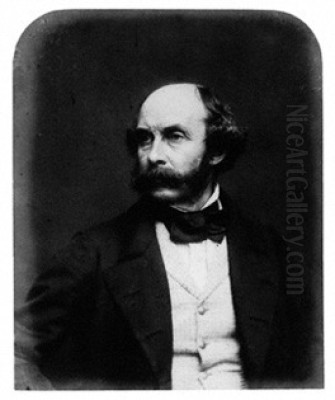
Frederick Richard Lee stands as a significant figure in the rich tapestry of 19th-century British landscape painting. Active during a period of great change and artistic development, Lee carved out a distinct niche for himself, celebrated for his faithful depictions of the natural world, particularly his skillful rendering of atmospheric effects, light, and shadow. His long and successful career saw him rise through the ranks of the prestigious Royal Academy of Arts, achieve considerable financial success, and leave behind a body of work admired for its technical proficiency and evocative portrayal of both British and continental scenery.
Early Life and Artistic Formation
Born on June 10, 1798, in the town of Barnstaple, Devon, Frederick Richard Lee entered a world where the appreciation of landscape art was steadily growing. His father, Thomas Lee, was an architect, a profession that may have instilled in the young Frederick an appreciation for structure and form, albeit one he would later apply to the organic shapes of nature rather than buildings. Devon itself, a county renowned for its picturesque coastlines, rolling hills, and verdant river valleys, provided ample inspiration for a budding landscape artist. The natural beauty surrounding his childhood home likely played a formative role in shaping his artistic sensibilities.
Lee's formal artistic training began relatively early. After an initial period in the army, which he reportedly left due to health reasons, he turned his focus entirely to art. He enrolled at the Royal Academy Schools in London in 1818. The RA Schools were the preeminent institution for artistic education in Britain at the time, providing rigorous training grounded in drawing from casts, life models, and the study of Old Masters. Here, Lee would have honed his technical skills alongside other aspiring artists, immersing himself in the academic traditions that shaped British art.
Ascendancy at the Royal Academy
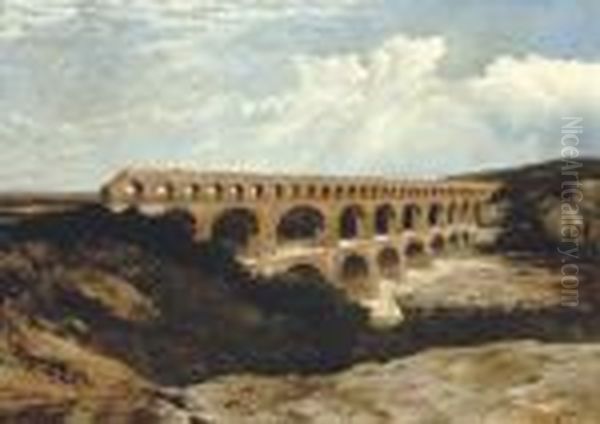
Lee began exhibiting his works publicly in 1824, primarily at the Royal Academy's annual exhibitions. These exhibitions were crucial platforms for artists seeking recognition and patronage. His talent for landscape painting quickly gained notice. His ability to capture the specific character of the British countryside, often imbued with a sense of tranquility and naturalism, resonated with the tastes of the time. The public and critics alike appreciated his skill in depicting foliage, water, and, notably, the ephemeral qualities of the sky – the shifting clouds and the play of sunlight and shadow across the land.
His growing reputation was formally acknowledged by the Royal Academy. In 1832, he was elected an Associate of the Royal Academy (ARA), a significant step indicating peer recognition. Just six years later, in 1838, he achieved the highest rank, being elected a full Royal Academician (RA). This prestigious title cemented his position within the British art establishment and brought further opportunities and prestige. Throughout the following decades, Lee remained a consistent and popular exhibitor at the Academy.
Artistic Style: Naturalism and Atmosphere
Lee's style is best characterized as naturalistic. He belonged to a generation of British landscape painters who moved away from the idealized, classical landscapes of earlier periods, influenced partly by the Dutch landscape tradition but more significantly by the burgeoning Romantic sensibility towards nature and the direct observations championed by artists like John Constable. While perhaps not as revolutionary as Constable or as dramatically sublime as J.M.W. Turner, Lee excelled in capturing the tangible reality of a scene.
A key feature of his work was his mastery of atmospheric effects. Contemporaries noted his particular skill in painting skies, capturing the fleeting forms of clouds and the subtle gradations of light that define the mood of a landscape. This focus aligns with the sentiment expressed by the poet William Wordsworth (though perhaps referring to William Collins), who believed that "Nature is always worthy of being painted." Lee seemed to embody this idea, finding endless fascination in the specific details and ambient conditions of the natural world. His handling of light and shadow (chiaroscuro) was often subtle but effective, lending depth and realism to his compositions.
His technique involved careful observation combined with proficient handling of oil paint. His brushwork could be detailed in the foreground elements like foliage and rocks, while broader strokes might be used for skies and distant vistas, creating a convincing sense of space and atmosphere. His colour palettes were generally naturalistic, reflecting the greens, blues, and earth tones of the landscapes he depicted, though often heightened for pictorial effect.
Themes and Subjects
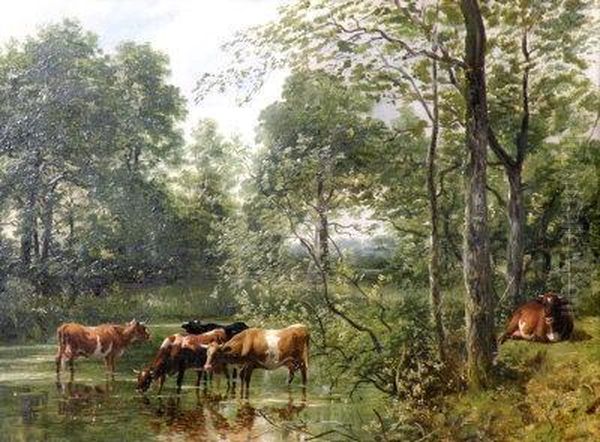
While primarily known for his British landscapes, particularly scenes from his native Devon, Lee's subject matter was varied. He painted tranquil river scenes, often featuring anglers or boats, capturing the reflective qualities of water and the lush vegetation along the banks. Coastal scenes, depicting the rugged cliffs and shores of Britain, also featured in his oeuvre. Wooded interiors, showing dappled sunlight filtering through trees, were another common theme.
Beyond purely natural landscapes, Lee often incorporated elements that added narrative interest or historical resonance. Castles and ruins sometimes appeared, evoking a sense of history and the passage of time, popular themes in the Romantic era. Figures were often included, usually small in scale, serving to animate the scene and provide a sense of human presence within the vastness of nature. These figures might be rural workers, travellers, or simply individuals enjoying the scenery, contributing to the overall narrative or mood of the painting.
Lee also travelled, and his journeys provided fresh subjects. He painted scenes in France, and potentially other parts of Europe, demonstrating his ability to capture the distinct character of foreign landscapes. This willingness to explore different terrains broadened the scope of his work beyond the familiar British countryside.
Notable Works: 'Le Pont du Gard' and Beyond
Among Lee's most celebrated works is Le Pont du Gard. This painting depicts the magnificent Roman aqueduct bridge in the south of France. The work is notable for its dramatic composition and perspective. Lee chose a viewpoint that emphasizes the massive scale and engineering prowess of the ancient structure, contrasting its enduring stone arches with the surrounding natural landscape and the flowing river beneath. The painting showcases his skill in rendering architecture within a natural setting and his ability to convey a sense of grandeur and historical weight. It reflects the Victorian era's fascination with history, engineering, and the picturesque qualities of continental Europe.
Another documented work is Garibaldi's House at Caprera, now held by the Metropolitan Museum of Art in New York. This painting points to Lee's engagement with contemporary subjects. Giuseppe Garibaldi was a major figure in the Italian Risorgimento and a celebrated hero in Britain. Depicting his home on the island of Caprera would have resonated with a public interested in current events and heroic figures. The choice of subject suggests Lee was attuned to the interests of his audience beyond purely scenic views.
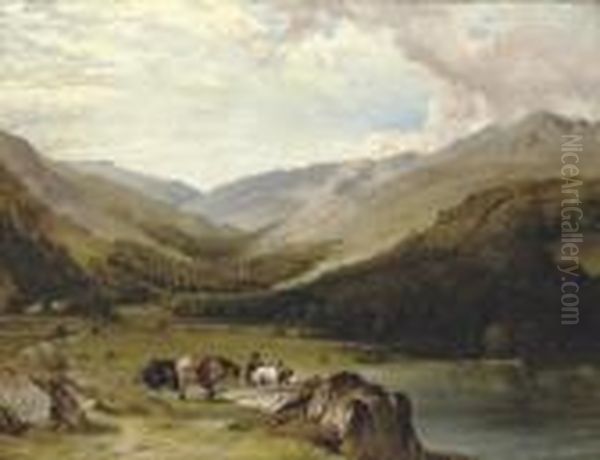
While these are specific examples, Lee produced a large volume of work throughout his career. Many paintings titled simply Landscape, River Scene, or named after specific locations in Devon, Scotland, or elsewhere in Britain, form the bulk of his output. These works consistently demonstrate his commitment to naturalistic representation and his sensitivity to light and atmosphere.
Collaborations and Contemporaries
Collaboration between artists, particularly specialists, was not uncommon in the 19th century. Lee engaged in notable partnerships, most famously with Thomas Sidney Cooper (1803-1902). Cooper, often nicknamed 'Cows' Cooper, was the preeminent painter of cattle and sheep in Victorian Britain. Starting around 1847 and continuing for nearly three decades, Lee and Cooper produced joint works where Lee would paint the landscape setting, and Cooper would add the animals. This combination played to both artists' strengths, resulting in highly popular and commercially successful pictures that combined Lee's scenic skills with Cooper's mastery of animal anatomy and texture.
Lee also collaborated for a time with Sir Edwin Landseer (1802-1873), one of the most famous and versatile artists of the era, renowned for his dramatic animal paintings and favoured by Queen Victoria. Landseer, like Cooper, would add figures or animals to Lee's landscapes. However, this partnership reportedly ended abruptly due to a quarrel between the two artists over a game, possibly billiards or cards. This anecdote highlights the sometimes-prickly personalities within the close-knit London art world.
Placing Lee within the context of his contemporaries helps understand his position. He worked alongside other prominent landscape painters such as David Cox (1783-1859) and Peter De Wint (1784-1849), though they were perhaps more famous for their watercolours. Clarkson Stanfield (1793-1867) was another highly successful RA known for marine paintings and landscapes, often with a more dramatic flair. David Roberts (1796-1864) specialized in topographical and architectural views, particularly of the Near East and Europe. Lee's work shares the naturalistic impulse seen in Constable but generally avoids the high drama of Turner or the intensely detailed, brightly coloured approach to landscape later adopted by the Pre-Raphaelites like John Everett Millais (1829-1896) in the backgrounds of paintings like Ophelia. He sits comfortably within the mainstream of successful Victorian landscape painting. Other notable figures in the broader art scene whose careers overlapped with Lee's include William Mulready, known for genre scenes, Richard Parkes Bonington, a brilliant landscape and historical painter who died young, and Samuel Palmer, known for his unique visionary landscapes of Shoreham.
Travel, Interests, and Later Life
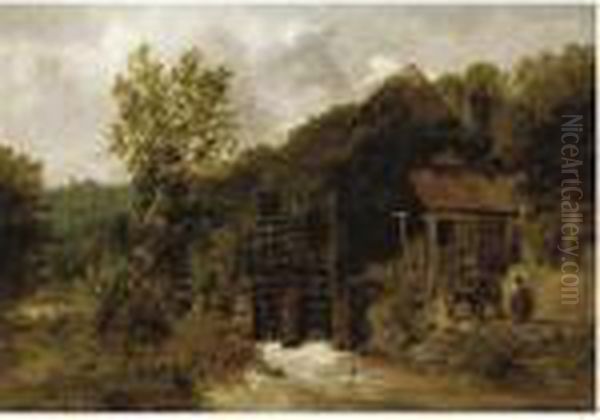
Lee's financial success allowed him pursuits beyond painting. He was reportedly an enthusiastic yachtsman, owning his own yacht and undertaking extensive travels. This passion for the sea may have informed some of his coastal scenes. His travels were not limited to Britain; his depiction of the Pont du Gard confirms his time in France, and he likely visited other parts of the continent, seeking out picturesque and historically significant sites.
Interestingly, Lee is said to have been influenced by or associated with figures from the world of science and engineering, such as the renowned railway engineer Robert Stephenson and the geologist Thomas Sopwith. This connection hints at the broader Victorian culture where art, science, and industry often intersected. An appreciation for geology might inform a landscape painter's understanding of landforms, while an association with engineers could reflect a shared interest in structure and large-scale projects, perhaps subtly influencing his depiction of works like the Pont du Gard.
After a long and productive career, Frederick Richard Lee retired from the Royal Academy in 1870. He did not, however, cease his artistic activities entirely. Seeking warmer climates, possibly for health reasons or simply a change of scenery, he spent his later years abroad. He passed away on June 5, 1879, in Veytaux, Switzerland, although some sources mention connections to South Africa in his final years.
Legacy and Collections
Frederick Richard Lee left a legacy as a highly competent and respected landscape painter who achieved significant success within the Victorian art world. While perhaps not considered an innovator on the scale of Turner or Constable, he was a master of his craft, producing works that were admired for their naturalism, atmospheric sensitivity, and technical skill. He represented a popular and enduring strand of British landscape painting that celebrated the beauty of the natural world in a detailed yet evocative manner.
His success during his lifetime ensured his work entered numerous private collections. Today, his paintings are also held in major public institutions, attesting to his historical significance. Notable collections include the Tate Britain in London, the Victoria and Albert Museum, the British Museum, the National Gallery of London, and internationally, the Metropolitan Museum of Art in New York. The presence of his work in these prestigious museums allows contemporary audiences to appreciate the skill and vision of this dedicated chronicler of the 19th-century landscape. His collaborations, particularly with Thomas Sidney Cooper, also remain points of interest for art historians studying artistic practice and the art market of the period. Frederick Richard Lee remains an important figure for understanding the breadth and depth of British landscape painting in the Victorian age.